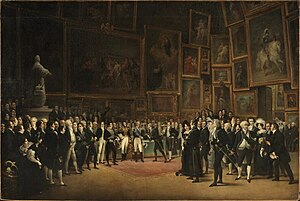Salon (Paris)

The Salon (French: Salon), or rarely Paris Salon (French: Salon de Paris [salɔ̃ də paʁi]), beginning in 1667[1] was the official art exhibition of the Académie des Beaux-Arts in Paris. Between 1748 and 1890 it was arguably the greatest annual or biennial art event in the Western world. At the 1761 Salon, thirty-three painters, nine sculptors, and eleven engravers contributed.[2] From 1881 onward, it was managed by the Société des Artistes Français.
Origins
In 1667, the royally sanctioned French institution of art patronage, the

In 1725, the Salon was held in the Palace of the Louvre, when it became known as Salon or Salon de Paris. In 1737, the exhibitions, held from 18 August 1737 to 5 September 1737 at the Grand Salon of the Louvre,[3] became public. They were held, at first, annually, and then biennially, in odd-numbered years. They would start on the feast day of St. Louis (25 August) and run for some weeks. Once made regular and public, the Salon's status was "never seriously in doubt".[4] In 1748 a jury of awarded artists was introduced. From this time forward, the influence of the Salon was undisputed.
Prominence (1748–1890)

The Salon exhibited paintings floor-to-ceiling and on every available inch of space. The jostling of artwork became the subject of many other paintings, including Pietro Antonio Martini's Salon of 1785. Printed catalogues of the Salons are primary documents for art historians. Critical descriptions of the exhibitions published in the gazettes mark the beginning of the modern occupation of art critic. The French salon, a product of the Enlightenment in the early 18th century, was a key institution in which women played a central role. Salons provided a place for women and men to congregate for intellectual discourse.
The French Revolution opened the exhibition to foreign artists. In the 19th century the idea of a public Salon extended to an annual government-sponsored juried exhibition of new painting and sculpture, held in large commercial halls, to which the ticket-bearing public was invited. The vernissage (varnishing) of opening night was a grand social occasion, and a crush that gave subject matter to newspaper caricaturists like Honoré Daumier. Charles Baudelaire, Denis Diderot and others wrote reviews of the Salons.
After the French Revolution of 1848 liberalized the Salon, far fewer works were refused. Medals were introduced in 1849.
Early splinter groups
The increasingly conservative and
In 1881 the government withdrew official sponsorship from the annual Salon, and a group of artists organized the Société des Artistes Français to take responsibility for the show.[1]
Secessions
In December 1890, the leader of the Société des Artistes Français,
In 1903, in response to what many artists at the time felt was a bureaucratic and conservative organization, a group of painters and sculptors, led by Pierre-Auguste Renoir and Auguste Rodin, organized the Salon d'Automne.
As the number of salons increased, American newspapers sometimes referred to the original salon as the Salon of the Champs Elysees.[9]
See also
|
Other salons
|
Gallery
-
Salon of 1753
-
Salon of 1767
-
etching by Pietro Antonio Martini
-
Salon of 1849, held at the Tuileries Palace
-
Honoré Daumier, Bourgeoises scandalized by the Salon's Venuses, 1864
-
Edouard Dantan, Un Coin du Salon en 1880
-
Salon of 1932, Grand Palais, Paris
References
- ^ a b c "Salon French art exhibition". britannica.com. Retrieved 14 June 2015.
- ISBN 0300064942
- ^ Berger, Robert W. Public Access to Art in Paris: A Documentary History from the Middle Ages to 1800, p. 171.
- ^ Crow, 1987
- ^ "The End of the Salon and the Rise of Impressionism". radford.edu. Retrieved 14 June 2015.
- ^ King, Ross (2009). The Judgment of Paris: The Revolutionary Decade that Gave the World Impressionism. New York: Bloomsbury. pp. 59–60
- ^ Auguste Dalligny, 'Société Nationale des Beaux-Arts – l'Exposition du Champ de Mars', Journal des Arts, 16 May 1890
- ^ Paul Bluysen, 'Le Salon du Champ de Mars – IV, La République francaise, 23 June 1890
- ^ "An American Colored Artist Wins the Medal of Honor. Letter in New York Post". The Indianapolis Journal. Indianapolis, Indiana. 13 June 1897. p. 12.
At the opening of the Salon of the Champs Elysees--the only salon conferring official honors--a painting by a new American artist was favorably noticed.
Sources
- J. J. Marquet de Vasselot: Répertoire des catalogues du musée du Louvre, 1793–1917
- Thomas Crow: Painters and Public Life in 18th Century Paris. Yale University Press 1987
- Patricia Mainardi: The End of the Salon: Art and the State in the Early Third Republic, Cambridge University Press, 1993.
- Fae Brauer, Rivals and Conspirators: The Paris Salons and the Modern Art Centre, Newcastle upon Tyne, Cambridge Scholars, 2013.
- Albert Boime, "The Salon des Refuses and the Evolution of Modern Art", Art Quarterly 32 (Winter 1969): 41 1-26
- Margo Bistis, "Bad Art: The Decline of Academic Art in the Caricatural Salon", International Journal of Comic Art 7, no.1 (Spring 2005); 126–148.
External links
- Timeline of the Paris Salons
- Harriet Griffiths and Alister Mill, Database of Salon Artists, 1827-1850 (salonartists.org)
- Catalogue illustré du Salon, 1879 – 1913. Gallica, Bibliothèque nationale de France







